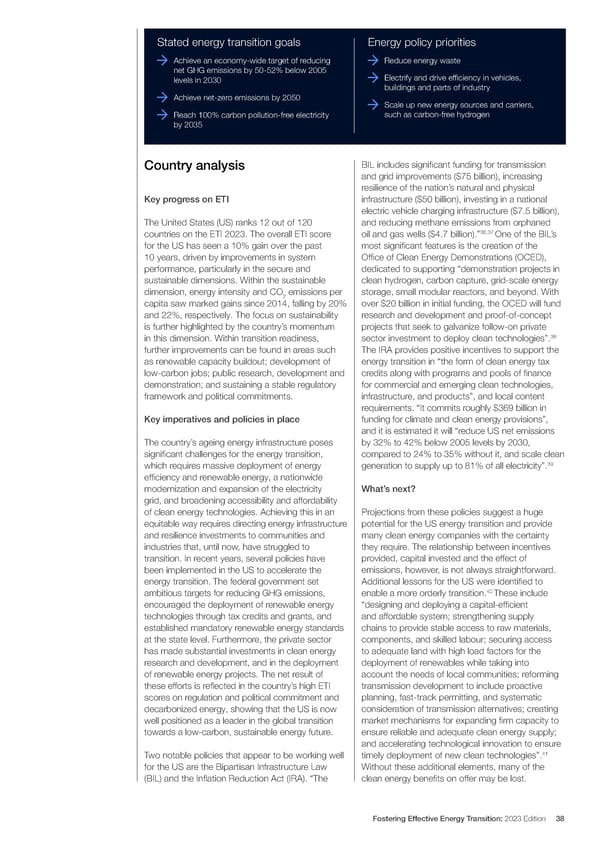Stated energy transition goals Energy policy priorities Achieve an economy-wide target of reducing Reduce energy waste net GHG emissions by 50-52% below 2005 Electrify and drive ef昀椀ciency in vehicles, levels in 2030 Achieve net-zero emissions by 2050 buildings and parts of industry Scale up new energy sources and carriers, Reach 100% carbon pollution-free electricity such as carbon-free hydrogen by 2035 BIL includes signi昀椀cant funding for transmission Country analysis and grid improvements ($75 billion), increasing resilience of the nation’s natural and physical Key progress on ETI infrastructure ($50 billion), investing in a national electric vehicle charging infrastructure ($7.5 billion), The United States (US) ranks 12 out of 120 and reducing methane emissions from orphaned 36,37 countries on the ETI 2023. The overall ETI score oil and gas wells ($4.7 billion).” One of the BIL’s for the US has seen a 10% gain over the past most signi昀椀cant features is the creation of the 10 years, driven by improvements in system Of昀椀ce of Clean Energy Demonstrations (OCED), performance, particularly in the secure and dedicated to supporting “demonstration projects in sustainable dimensions. Within the sustainable clean hydrogen, carbon capture, grid-scale energy dimension, energy intensity and CO emissions per storage, small modular reactors, and beyond. With 2 capita saw marked gains since 2014, falling by 20% over $20 billion in initial funding, the OCED will fund and 22%, respectively. The focus on sustainability research and development and proof-of-concept is further highlighted by the country’s momentum projects that seek to galvanize follow-on private in this dimension. Within transition readiness, sector investment to deploy clean technologies”.38 further improvements can be found in areas such The IRA provides positive incentives to support the as renewable capacity buildout; development of energy transition in “the form of clean energy tax low-carbon jobs; public research, development and credits along with programs and pools of 昀椀nance demonstration; and sustaining a stable regulatory for commercial and emerging clean technologies, framework and political commitments. infrastructure, and products”, and local content requirements. “It commits roughly $369 billion in Key imperatives and policies in place funding for climate and clean energy provisions”, and it is estimated it will “reduce US net emissions The country’s ageing energy infrastructure poses by 32% to 42% below 2005 levels by 2030, signi昀椀cant challenges for the energy transition, compared to 24% to 35% without it, and scale clean 39 which requires massive deployment of energy generation to supply up to 81% of all electricity”. ef昀椀ciency and renewable energy, a nationwide modernization and expansion of the electricity What’s next? grid, and broadening accessibility and affordability of clean energy technologies. Achieving this in an Projections from these policies suggest a huge equitable way requires directing energy infrastructure potential for the US energy transition and provide and resilience investments to communities and many clean energy companies with the certainty industries that, until now, have struggled to they require. The relationship between incentives transition. In recent years, several policies have provided, capital invested and the effect of been implemented in the US to accelerate the emissions, however, is not always straightforward. energy transition. The federal government set Additional lessons for the US were identi昀椀ed to 40 ambitious targets for reducing GHG emissions, enable a more orderly transition. These include encouraged the deployment of renewable energy “designing and deploying a capital-ef昀椀cient technologies through tax credits and grants, and and affordable system; strengthening supply established mandatory renewable energy standards chains to provide stable access to raw materials, at the state level. Furthermore, the private sector components, and skilled labour; securing access has made substantial investments in clean energy to adequate land with high load factors for the research and development, and in the deployment deployment of renewables while taking into of renewable energy projects. The net result of account the needs of local communities; reforming these efforts is re昀氀ected in the country’s high ETI transmission development to include proactive scores on regulation and political commitment and planning, fast-track permitting, and systematic decarbonized energy, showing that the US is now consideration of transmission alternatives; creating well positioned as a leader in the global transition market mechanisms for expanding 昀椀rm capacity to towards a low-carbon, sustainable energy future. ensure reliable and adequate clean energy supply; and accelerating technological innovation to ensure 41 Two notable policies that appear to be working well timely deployment of new clean technologies”. for the US are the Bipartisan Infrastructure Law Without these additional elements, many of the (BIL) and the In昀氀ation Reduction Act (IRA). “The clean energy bene昀椀ts on offer may be lost. Fostering Effective Energy Transition: 2023 Edition 38
 Fostering Effective Energy Transition 2023 Page 37 Page 39
Fostering Effective Energy Transition 2023 Page 37 Page 39